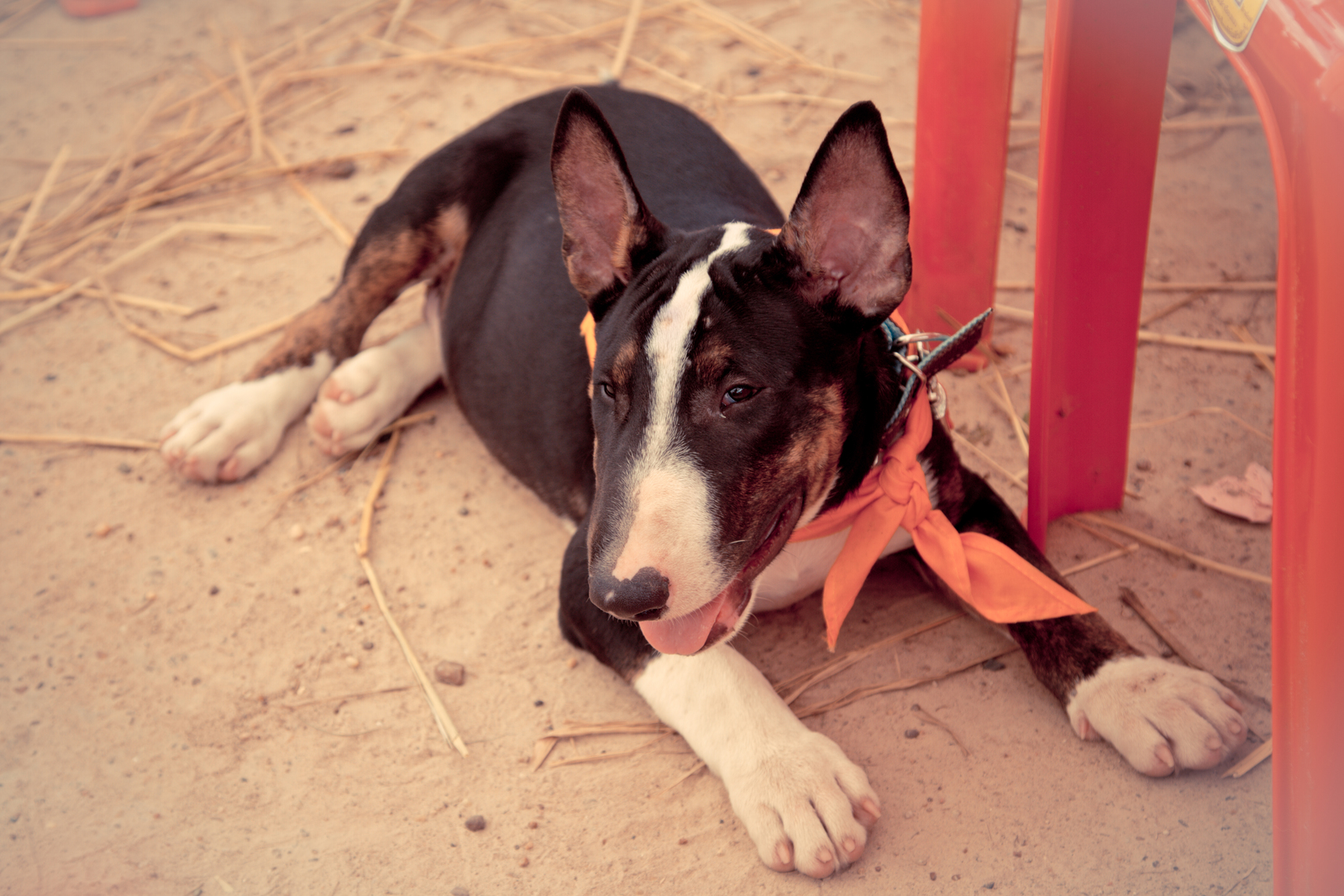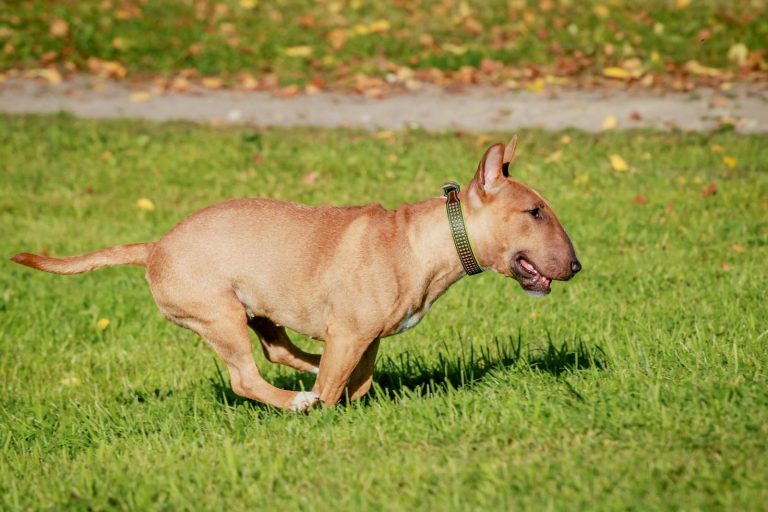Bull Terriers and Miniature Bull Terriers share many traits but differ in size. These breeds have distinct histories and physical features that set them apart. Let’s explore about them!
If you’re still on the market to buy a Bull or Miniature Bull Terrier, PuppySpot currently offers a $300 discount using the code PUPPY300, just click the banner below!
Physical Characteristics
- Bull Terriers and Mini Bull Terriers share a unique egg-shaped head. This feature sets them apart from other dog breeds.
- Both have small, triangular eyes and erect ears. Their bodies are muscular and sturdy, with a short, dense coat.
- Coat colors include white, black, brindle, red, and fawn. Some dogs have solid colors, while others have patterns or markings.
- Their tails are thick at the base and taper to a point. When excited, they hold their tails up and wagging.
Size and Weight
- The main difference between these breeds is their size. Bull Terriers are larger, standing 21-22 inches tall at the shoulder. They typically weigh between 50-70 pounds.
- Miniature Bull Terriers are smaller, reaching 10-14 inches in height. Their weight ranges from 20-35 pounds.
- Despite the size difference, both breeds have similar proportions. They maintain the muscular build and confident stance of their larger counterparts.
- The size difference makes Mini Bull Terriers better suited for smaller living spaces. Standard Bull Terriers need more room due to their larger size.

Personality Traits
Bull Terriers and Miniature Bull Terriers share many character traits but have some notable differences. Their personalities shape how they interact with families, other pets, and strangers.
Temperament
- Bull Terriers are known for their strong-willed nature. They can be stubborn at times, which may make training a challenge. These dogs have high energy levels and need plenty of exercise.
- Miniature Bull Terriers are equally spirited but may be slightly easier to manage due to their smaller size. Both breeds are playful and enjoy being the center of attention.
- They thrive on human companionship and can become destructive if left alone for long periods. Early socialization is key for both varieties to ensure they grow into well-adjusted adults.
Behavior
- Bull Terriers and their miniature counterparts are known for their clownish antics. They love to entertain their families with silly behavior and playful tricks.
- These breeds are intelligent but can have a mischievous streak. They may test boundaries and need consistent training to maintain good manners.
- Both types are active and require regular mental and physical stimulation. Without proper outlets, they may engage in unwanted behaviors like excessive barking or chewing.
- Bull Terriers and Minis are generally good with children when raised together. However, their boisterous nature means supervision is important, especially with younger kids.
Affectionate Nature
- Both Bull Terrier varieties are loving and affectionate with their families. They form strong bonds and are often described as “velcro dogs” due to their desire to be close to their owners.
- These breeds enjoy cuddling and physical affection. They may try to be lap dogs despite their size, especially the Miniature Bull Terrier.
- While devoted to their families, they can be reserved with strangers. Proper socialization helps them become more accepting of new people.
- Bull Terriers and Minis are known to be patient and gentle with children in their family. They often become protective of their young human companions.
Aggression and Prey Drive
- Bull Terriers and Miniature Bull Terriers have a moderate prey drive. This instinct may cause them to chase small animals or moving objects.
- Early training and socialization can help manage this behavior. It’s important to keep these dogs on a leash or in a secure area when outdoors.
- While not typically aggressive towards humans, they can be territorial. They may not always get along with other dogs, especially those of the same sex.
- Proper introductions and supervision are crucial when introducing them to new pets. With the right approach, many Bull Terriers and Minis can learn to coexist peacefully with other animals.
Health and Wellbeing
Bull Terriers and Miniature Bull Terriers share many health traits, but have some key differences in their care needs. Both breeds require regular vet check-ups to stay healthy.
Common Health Issues
- Bull Terriers and Mini Bull Terriers face similar health challenges. Deafness and skin allergies are common in both breeds. They may also develop heart problems.
- Miniature Bull Terriers can be prone to patellar luxation, a knee condition. Both breeds may experience eye issues like glaucoma.
- Regular vet visits are crucial for early detection of these problems. Owners should watch for signs of discomfort or changes in behavior.
Exercise Requirements
- Bull Terriers and Mini Bull Terriers have high energy levels. They need daily exercise to stay healthy and happy.
- A mix of walks, playtime, and mental stimulation works well. Aim for at least 30-60 minutes of activity per day.
- These breeds enjoy games that challenge their minds. Puzzle toys and training sessions can help meet their exercise needs.
- Without enough activity, they may become destructive or develop behavior issues.
Grooming Needs
- Both breeds have short, dense coats that are relatively easy to maintain. Weekly brushing helps remove loose hair and keeps their coat shiny.
- They shed moderately year-round. Regular grooming can help control shedding and distribute skin oils.
- Bathe them only when necessary to avoid drying out their skin. Trim their nails regularly and clean their ears to prevent infections.
- Dental care is important for both breeds. Brush their teeth several times a week to prevent dental issues.

Living with a Bull Terrier
Bull Terriers can be great family pets, but they have specific needs and traits to consider. These dogs require proper training, exercise, and care to thrive in a home environment.
Apartment Living
- Bull Terriers can adapt to apartment living with the right care. They need daily exercise to burn off energy. A few brisk walks or play sessions each day can help keep them happy.
- These dogs have a sturdy build. Owners should be mindful of their strength in smaller spaces. Bull Terriers may bump into things or knock items over by accident.
- Training is key for apartment life. Teaching them to be quiet and calm indoors is important. This helps prevent noise complaints from neighbors.
Shedding and Maintenance
- Bull Terriers have short, dense coats that shed moderately. They need regular brushing to keep shedding under control. A weekly brush is usually enough to remove loose hair.
- These dogs don’t need frequent baths. Washing them every few months or when they get dirty is sufficient. Their nails grow fast and need regular trimming.
- Bull Terriers can drool, especially after eating or drinking. Wiping their face helps keep them clean. Regular teeth brushing is important for their dental health.
Interaction with Children and Other Pets
- Bull Terriers can be good with children when raised together. They are playful and energetic, which kids often enjoy. But their size and strength mean supervision is crucial.
- These dogs might chase smaller pets due to their high prey drive. Early socialization helps them get along with other animals. Proper introductions are key when bringing new pets home.
- Bull Terriers can be stubborn. Consistent training from an early age helps them learn good behavior around kids and pets. Teaching children how to interact safely with the dog is also important.




